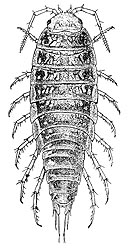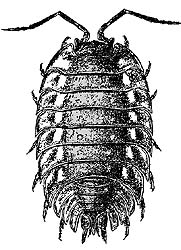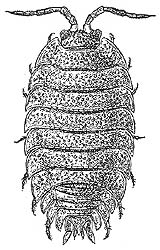




(native)
demivirgo
(common, introduced)
(common, introduced)
vulgare (pillbug)
BUG OF THE MONTH: November 1995
Sowbugs and Pillbugs
Order Isopoda, superfamily Oniscoidea
Copyright © 1995 by Louise Kulzer
This article originally appeared in Scarabogram, Nov. 1995, New Series No. 187, pp. 2-3.
Every gardener who has lifted up flowerpots or boards knows sowbugs (also called woodlice or, if you're from Lynnwood, potato bugs). They're those flat grey armadillo-like critters with lots of segments and legs. I'm always amazed by the deep emotional response sowbugs evoke. The more casual the gardener, the more negative the response: loathing, fear, disgust. But we're gonna change all that. Cloaked with knowledge and insight you, gentle reader, can start a revolution based on simple observation. For sowbugs are an incredibly fascinating group of animals that will awaken a sense of appreciation, if not wonder, in all who stop and look.
 |
 |
 |
 |
 |
| Ligidium gracile (native) |
Trichoniscus demivirgo |
Oniscus asellus (common, introduced) |
Porcellio scaber (common, introduced) |
Armadillidium vulgare (pillbug) |
| The flagellum (end section) of the antenna has 10+ segments in Ligidium; 5 segments in Trichoniscus; 3 in Oniscidae; 2 in Porcellionidae. In Armadillididae, the uropods and telson (at end of body) do not stick out. | ||||
We're off to a fast start, since you already can tell a pillbug from a sowbug (you just didn't know it). If it rolls up when you poke it, it's a pillbug (family Armadillididae). If it doesn't, it's a sowbug (potato bug in Lynnwood). Our most common sowbugs are in the families Porcellionidae and Oniscidae (Sutton et al. 1972). Pillbugs are not native here and neither are the common garden sowbugs. We do have native sowbugs that live in the forest duff (they are better called woodlice, but that's hair-splitting).
If you're not into poking sowbugs, you can also tell rollers from non-rollers by their general degree of body convexity (see diagram). And for the trivia fact of the month, the act of rolling into a ball is formally called conglobulating! Honest, I wouldn't joke about scientific terms.

Next, some basics.
1. Isopods are not insects; they belong to the class Crustacea, mainly marine animals with a calcareous exoskeleton and jointed appendages, like crabs. (The jointed legs make them arthropods, close enough to bugs to appear in this column). Only a few families of isopods are terrestrial (superfamily Oniscoidea); their brethren are marine (never left home, so to speak) and a few live in fresh water.
2. When they became terrestrial, isopods had to adapt to breathing air. They respire by gas exchange through the pleopods, appendages on the underside of the abdomen (Kummel 1984). This is important in rainy climates, since waterlogged pleopods are more than just wet feet - they are equivalent to drowning.
3. Water regulation also became necessary when isopods went landward. A water duct system is present which is also used to dispel nitrogenous waste. Ammonia compounds are converted to nitrogen gas as the duct system becomes more alkaline (Wieser 1984). Imagine, excreting waste gas instead of waste liquid. Kind of like a slow-moving car!
4. Isopods feed mostly on litter (dead plant material) and fecal matter in the soil. But they also feed on living plants, and here's the rub. Gardeners are sure they eat the choicest and most delectable garden plants. Actually, I found no information about which garden foods they like, but in the laboratory, a mixture of soil, grass litter, dry leached thistle leaves and sliced carrots was relished. Doesn't sound too dangerous, huh? Actually, isopods in the wild do have decided food preferences. Even so, in one California study they ate whatever was at hand. They also can vary the rate at which digestion occurs to adjust to less preferred foods and differing environmental conditions (Paris 1963).
One more thing about feeding: sowbugs have the amazing ability to store very high concentrations of metals in the hepatopancreas. This trait has been used by wily scientists to study metal contamination of various environments (Hopkin 1990).
5. Female isopods have a marsupium, a brood pouch in which the eggs are incubated until they hatch. The young leave the brood pouch and typically molt soon after: in Porcellio laevis, within 24 hours (Nair 1984). After leaving the marsupium, they live in family groups until the young are grown. Each family has a chemical "badge" which distinguishes it from the rest of the population (Linsenmair 1984). Can you ever crush an isopod again knowing this?
Now if that doesn't convince you not to step on sowbugs, you're just not the sensitive type! Go forth, watch sowbugs, grow in grace and wisdom.
References
Hoesse, B. 1984, The marsupium in terrestrial isopods. in: S. Sutton & D. Holdrich, The Biology of Terrestrial Isopods.
Hopkin, S.P. 1990. Species specific differences in the net assimilation of zinc, cadmium, lead, copper and iron by the terrestrial isopods Oniscus asellus and Porcellio scaber. Journal of Applied Ecology, 27: 460-474.
Kummel, G. 1984. Fine-structural investigations of the pleopodal endopods of terrestrial isopods with some remarks on their function. in: S. Sutton & D. Holdrich, The Biology of Terrestrial Isopods.
Linsenmair, K. 1984. Comparative studies on the social behavior of the desert isopod Hemilepistus reaumuri and of a Porcellio species. in: S. Sutton & D. Holdrich, The Biology of Terrestrial Isopods.
Paris, Oscar. 1963. The ecology of Armadillidium vulgare (Isopoda: Oniscoidea) in California grassland: food, enemies and weather. Ecological Monographs, 33(1): 1-22.
Sutton, S., P.Harding, and D.Burn. 1972. Key to British Woodlice. Ginn & Co. Ltd., London.
Weiser, W. 1984, Ecophysiological adaptations of terrestial isopods: a brief review. in: S. Sutton & D. Holdrich, The Biology of Terrestrial Isopods.
This page last updated 16 June, 2005